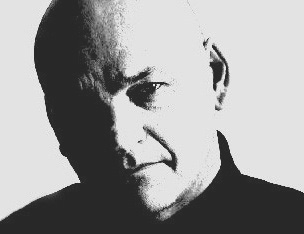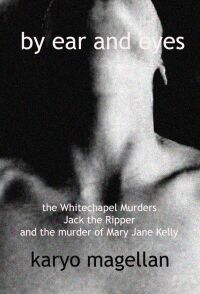|
life death
and murder
The belief in a supernatural source of evil is not necessary; men alone are
quite capable of every wickedness.
Joseph Conrad (Jozef Teodor Konrad Nalecz Korzeniowski; 1857–1924) Polish-born British
novelist. Under Western Eyes, Part 2
|
attitudes to death |
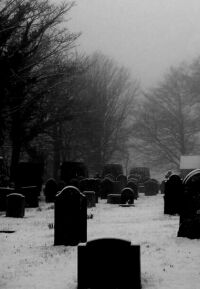 |
Only
during the past 60 years or so – since the end of World War II – has the
subject of death become something to be avoided and denied. Our ancestors
were less repulsed by the inevitable and to the Victorians death held
great fascination – influenced perhaps by Queen Victoria’s own extended
mourning following the death of her husband Prince Albert from typhoid
in 1861. It could be argued that the Victorians were a little too
fascinated by death and the invention of photography enabled them to
record their dead relatives for posterity in a manner than today we
would perhaps find uncomfortable at best, or obscene at worst.
Photographing the
dead for other than forensic purposes would be frowned upon today,
especially in Western Cultures, but not only did the Victorians
photograph the dead but they did so in posed and contrived circumstances
that suggested the deceased to be still alive. This done for adults and for children.
Was the philosophy
of the Victorians better or worse than our present day reluctance to
acknowledge death as a part of life? Our reticence when faced with the
subject is largely attributable to the fact that we no longer come into contact with death, dying and the dead in the
same way that our ancestors did or in the same way that people do in
other countries or cultures. Without an understanding and appreciation of death it
is doubtful that life can be treated with proper respect. Death has replaced
sex as the taboo subject in Western society. |
|
death - reality and deception
|
|
Since the middle of the nineteenth century
photography has been used to assist the police in the detection of
crimes. Paramount in this is the imaging of crime scenes – an valuable
tool to preserve the ephemeral state of victim and surroundings. Such
images
may subsequently, if not at the time, assist detection by recording
details that might otherwise have been missed. Although the camera can
be made to deceive, the strict manner in which forensic images are taken
minimises distortion of the facts.
The camera, so often associated with imaging
beauty, is uncompromising in the manner in which it records the reality
of death, especially violent death. The brutality, repulsion and
finality of death cannot be disguised and
knowledge that the scene is real takes the viewer beyond the image. It is impossible not to empathise with the victim’s final moments and
to embrace the deep sadness conveyed by a buttoned cardigan or tied shoelace –
rarely do we ever know that we are doing something for the last time.
Actions, so unimportant at the moment, would have assumed special
importance in a life with perhaps only hours left. |
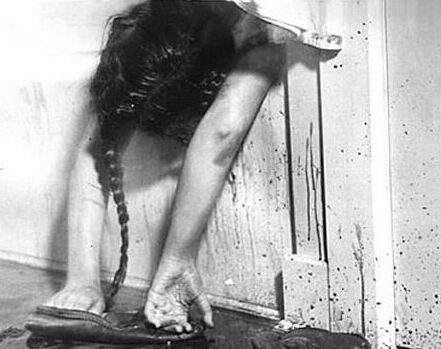 |
|
While we are generally detached from the
reality of death and even from images of real death we are daily bombarded
with make-believe death, and fantasy images of death and the portrayal of
violent death. There is a peculiar irony in this; we avoid confronting the reality of death
but gladly embrace the substituted fantasy.
Thus, when confronted by reality, we are ill-equipped. The preoccupation
of Western societies with fantasy death especially through fictional
literature and television drama tends also to create a state of
indifference. In fact, there exist two quite distinct polarisations that
induce indifference. At one end of the spectrum is the sanitised version
of events that keeps the subject matter at arm’s length and at the other
end is over-exposure to real violence which eventually numbs the senses.
Sanitised images and the fantasy portrayal of death do humanity a great disservice.
They do not bring us into close proximity with the true horror of
violent crime. |
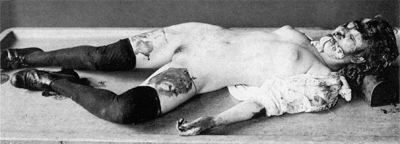 |
This girl was the victim of a brutal
murder. She was found dead in a barn with severe head injuries. We cannot for one
moment appreciate the terror suffered by the victim and in reality we
have no desire to do so because of the psychological consequences that
might follow. It is even too uncomfortable to consider the consequential
pain experienced by her friends and relatives; we can sympathise but
rarely do we empathise. How could
anyone inflict such injuries on a young and vulnerable victim? It seems
that in pursuit of base gratification her achievements in life and her
dreams for the future were worthless. At what point did her killer
decide that her life had no value? What kind of person has such a
complete disregard for human life? |
|
The image of the
murdered girl is disturbing for several obvious reasons. It is
uncomfortable to look at the image of her without experiencing feelings
of
guilt - this is a voyeuristic experience and it seems as though we
are viewing what we should not see - and that we are able to do so because of her misfortune.
Are we
invading her privacy? This image was taken as a record of an
event - perhaps as a source of information or as part of a scientific
exercise. If such an image is used to
inform - to depict what we otherwise would not see or understand - then
there should be no guilt, but such an image can also be regarded as
lurid or even salacious and there must inevitably be degrees of both. It
is important to remember that it is not the image that violates the
victim but the crime that brought them to the post mortem table. There
is no glamour in murder, only wrecked lives.
Essentially the plight
of the young girl was no different from that of Jack the Ripper victim
Catharine Eddowes, with the possible exception that Eddowes' ordeal was
not prolonged. However, the feelings consequential to viewing
the post mortem room images of her corpse, taken in 1888, seem to be different
but for no good reason.
Why does it seem less acceptable to look
at images of the young female victim above than to look at those of
Catharine Eddowes? Is it because Eddowes was much older, because she was
killed in a different era, or because she was a alcoholic prostitute?
Would our appreciation of the corpse of the young woman be different if
we knew that her lifestyle was perhaps on the edge of what society judges to be acceptable?
There should of course be absolutely no difference in our appreciation
of any murder victim merely because if their age, appearance, lifestyle,
or circumstances. In these examples both women met with a terrible death
and their suffering during the attack was beyond comprehension. |
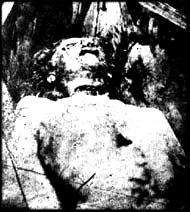 |
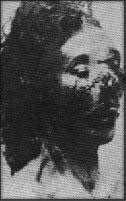 |
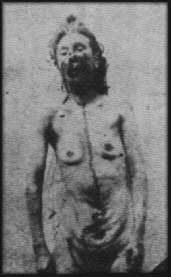 |
These photographs of the unfortunate
Catharine Eddowes were taken firstly as she lay in a coffin and before the
autopsy was undertaken – the wounds to her neck mutilation to her facial
features and extensive cuts to her abdomen are clearly visible. The
second image was taken after the autopsy and after extensive
reconstruction and stitch-work to her corpse. The extended stitch-work
vertically across her chest and up to her neck followed the autopsy
examination – her killer did not mutilate her thorax. The photographs
after autopsy were taken with Eddowes’ corpse vertically arranged with
her hair tied to a fixing on the wall behind her head so that she
appeared to be standing. A rather
ignominious end to a sad life. |
|
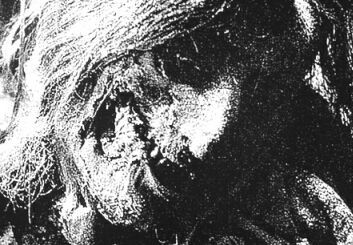
A 'smile' from death
Partially decomposed corpse
|
Jack the Ripper was certainly not the first serial killer in history but he
was one of the first to be acknowledged and to be documented as such.
Because methods of criminal investigation were somewhat lacking prior to the
twentieth century, the further
back in time one searches the the more difficult it becomes to link deaths as part
of a series and the less chance there was of apprehending the killer,
especially when victims were selected randomly.
Disturbingly, however, the State historically creates circumstances under which
serial killers can operate with impunity - such was the case centuries ago
and it is much the same now. Military combat is an obvious arena for
those with more than a passing interest in murder to practice their skills,
usually among the civilian population. However, while a state of war was a
particularly convenient cover under which multiple killers could
gratify their urges, a far more disturbing period in history allowed serial
killers not only to operate with impunity, but to select their victims for
torture and death with the total compliance of the State.
The witch hunts of the
sixteenth and seventeenth centuries were a horrific period in history from
which arose some notable individuals who self-styled themselves as witch
hunters but in truth they were driven by the same compulsions that drive the
psychopathic serial killer. Not only could they gratify their perversions at
will but they were rewarded financially for their endeavours, often from the
funds of the victims, who had to pay for their own torture and death. Water
torture as depicted in the image to the left was one of many techniques
employed to extract confessions but the witch finders were not necessarily interested in
the truth or otherwise of the accusation - the thrill for them was the
process of getting the confession which usually involved many bouts of
torture as the victims confessed under torture then retracted the confession
afterwards. Once an accusation of witchcraft was made, more often than not
against young and attractive women, excruciating torture was the route
to an inevitable death by hanging in England or Colonial America, or by
being burned alive in Scotland and the countries of continental Europe. Gratification for
the witch finders came from the terror that they induced in their hapless
victims and from the absolute power that they exercised.
The darker aspects of human
behaviour appeal to many writers, and psychopathy, the darkest of all,
provides a rich source. Not all
psychopaths kill, but their total lack of empathy with, and sympathy for, the feelings of
others leads them to cause disruption and damage in many other ways
to those who come into contact with them. An extreme manifestation
of psychopathy is the desire to kill repeatedly and it is little wonder
that serial killers have become a fascinating subject of literary focus,
albeit disproportionate to true prevalence in society. Ever since
Jack the Ripper brought terror to the East End of London the fascination with serial killers has endured.
Severin Klosowski, who re-named himself George Chapman, was a psychopath who
serially murdered three 'wives', including Maud Adams with whom he is
pictured, by poisoning them with antimony. Klosowski has subsequently been
considered as a possible candidate for the role of Jack the Ripper and he
was certainly in the right place at the right time for all of the six
murders that I have identified as being attributable to the same killer.
There are however significant reasons to reject his candidature and these
are examined in By Ear and Eyes. Klosowski typically demonstrated a
psychopathic personality and in more ways than just the callous manner in
which he committed murder. He was executed in 1903.
It is immediately difficult to see how psychopathy
could ever be an advantage in evolutionary terms, but we live in an artificial world; a flimsy
veneer of civilised sociability in which antisocial behaviour is not
tolerated. A breakdown of society would lead to an entirely different environment in which man may
again
have to rely upon basic instincts for survival of the fittest. So, in the midst of anarchy, psychopaths may just beat the meek in the
race to inherit the earth! Society
should never underestimate the psychopath - they may appear poorly equipped, but like any other
trait it can be an advantage under the right circumstances. |
|
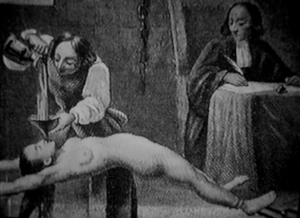
Confessions were extracted from 'witches'
under torture - water torture was one example
|
|
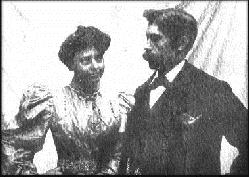
The psychopathic serial killer Severin
Klosowski with Maud Adams, 'wife' and victim
|
|
